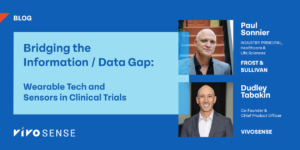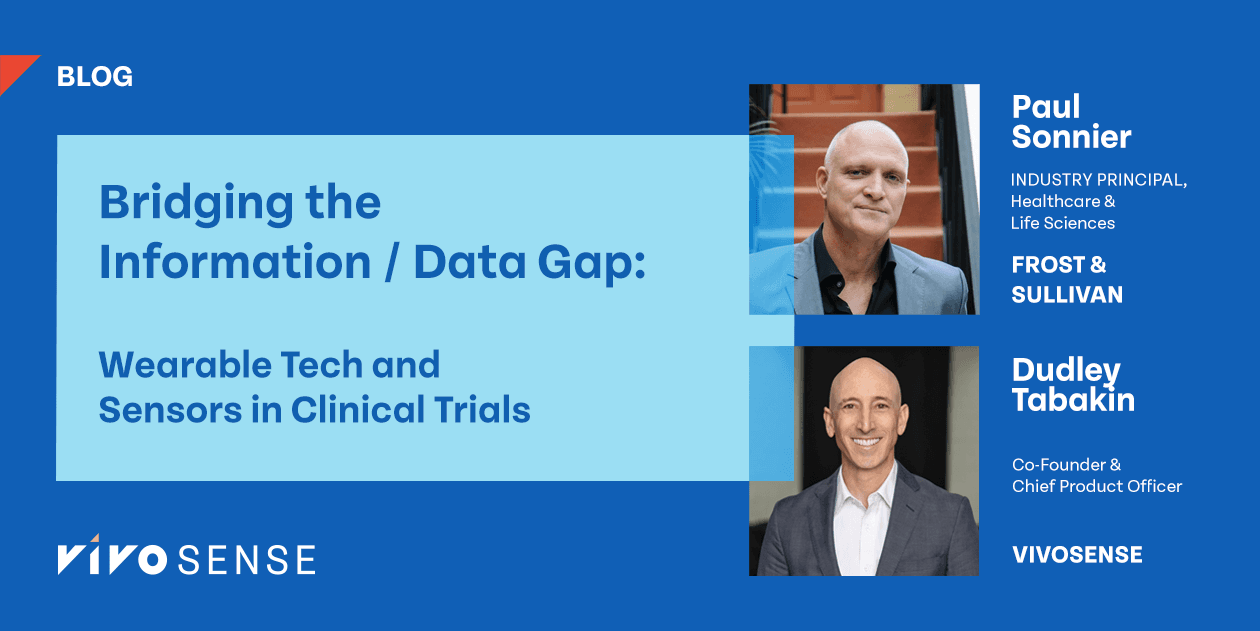
In this Hitlab panel discussion, VivoSense CEO Dudley Tabakin and Industry Principal Paul Sonnier discuss validating digital endpoints for their delivery in clinical trials using a patient-first approach that substantiates the efficacy or performance of their treatment.
Listen to the Discussion
Edited Transcript
Paul Sonnier: Always exciting to be part of the hit lab monthly symposium and joined by Dudley, who looks like my separated twin at birth based on our pictures! I am an industry principal at Frost and Sullivan, focused on healthcare and life sciences. We support clients in their growth journey through syndicated market intelligence research to support the voice of the customer, market strategy, and brand demand marketing solutions to support thought leadership, content marketing, and lead generation.
It’s great to be here talking with Dudley Tabakin, the CEO at Vivo sense. Dudley, can you tell us a little about what you’re doing to help your pharmaceutical clients and clinical trials, but give us a brief introduction and background on VivoSense?
Dudley Tabakin: Thanks, Paul. And, hello, everyone. And Paul and I do not coordinate our dress, but we do coordinate our haircuts!
Paul Sonnier: Yes, we do!
Dudley Tabakin: VivoSense develops and validates digital clinical measures and provides end-to-end services and solutions for their delivery in clinical trials. We believe you have to build up the evidence ahead of time so that you can deploy digital outcomes or digital measures into clinical trials.
We take a very patient-centric focus. When developing a digital outcome measure, we affirm that it is meaningful, important, and relevant to the patient. It’s a patient-first approach to using technology in clinical trials and getting to the point where a pharmaceutical sponsor or clinical trial can use the evidence to make a decision or show the efficacy or performance of their treatment.
Using Wearable Data in Clinical Trials
Paul Sonnier: Dudley, could you dive a little deeper into how you’re using wearable tech and sensors in clinical trials and pulling the data out of those devices?
Dudley Tabakin: Sure. I’ll go back to the fact that many wearable sensor technologies are on the market, both in the FDA-approved medical device area and on the consumer side. And both of them are very valuable in the data they collect. They collect so much information; we need to make meaning from that data.
VivoSense is sensor inclusive. We look at any sensor and the fit-for-purpose nature of that wearable technology. For example, in a clinical trial, putting on a wrist-worn actigraphy device might be the approach you want to take. However, if you’re trying to measure heart rate accurately, you might want an ECG patch, or you may need a respiration vest like the Hexoskin.
We focus on fit-for-purpose technology and ensuring that we deliver an outcome measure that is meaningful to the patient and of interest to the study. You may be able to measure steps from your wrist-worn activity device, but that might not be a relevant measure for that clinical trial or provide you with an appropriate finding that can be used to determine the efficacy of the treatment.
Steps to Validate Digital Endpoints
Paul Sonnier: Got it. To that end, what are the digital endpoints, and what steps do you take to validate them for use in clinical trials?
Dudley Tabakin: The validation of digital endpoints is critical. You must take a holistic validation approach when deploying digital technology into a clinical trial because your endpoint will need a lot of evidence for the FDA to approve your measurement.
We follow the V3 approach:
- • V1: Sensor Verification: Verify the sensor technology you will use. Does it measure what it says it measures?
- • V2: Analytical Validation: Validation of the analysis that’s being done. For example, if you’re counting steps per day in a Parkinson’s population, are you accurately counting steps for that population versus a healthy population? That’s the analytical validation piece.
- • V3: Clinical Validation: Finally, we come to clinical validation to understand whether we can measure something clinically relevant using this digital outcome measure.
You need to validate outcome measures with this V3 approach for the FDA or any other regulatory authority to accept them as meaningful clinical, primary, and secondary endpoints in the clinical trials.
When we look at a digital endpoint, we consider if we can measure a change from one state to another, from baseline to post-treatment. And if so, we have a relevant endpoint that can be measured and used as a treatment effect for that study.
Provide Value to Patients Beyond the Clinical Trials
Paul Sonnier: That’s a pretty good segue Dudley. So how do these digital outcome measures provide value to patients beyond the clinical trial?
Dudley Tabakin: We return to the V3 validation approach of validating a digital outcome measure. For example, when measuring walking or stepping in Parkinson’s disease, we can now use that measure in the real world, healthcare, and post-market settings more effectively because we have built up the evidence that shows clinically meaningful reasons to measure what we’re measuring.
The outcome measure must be meaningful aspects of health to the patient. Does the patient actually want to walk each day? Is that the most important thing to them? It may be, but that is something we need to understand on the front end, which is part of the validation process.
For example, I’m healthy, spend a lot of time behind my desk, and am pretty sedentary for that reason. Suppose I were to measure activity to understand how much moderate to vigorous activity I was doing each day. In that case, I might find that my physical activity level is almost the same as it is every other day because I spend so much time behind the desk. This measure now becomes less meaningful to me because I will see similar results for each day.
However, if I can measure something meaningful, such as whether I take my dog for a walk every day, we now have something we can measure that is meaningful to me as a patient. And now I have a reason to be engaged with wearable technology!
This level of patient engagement comes through providing validation and meaningful aspects of health evidence in the early stages of digital biomarker development that can be used in post-market surveillance and healthcare in the future. Doing the validation process first provides excellent opportunities for patients to benefit from wearable sensor technology and data.
Enable Decentralized Clinical Trials With Wearable Technology
Paul Sonnier: One last question for you, Dudley. Who do you partner with in clinical trials, and how do you enable decentralized clinical trials?
Dudley Tabakin: Great question. As mentioned, we are sensor inclusive. We work with Hexoskin and other medical-grade actigraphy devices and sensor patches. We also have worked with consumer devices like Apple Watches and Fitbits. We try and incorporate what fits the study’s purpose. That’s the one end: you have to bring in sensor technology.
Conversely, we work with CROs and decentralized clinical trial organizations, such as Medable and Science 37, to deliver the outcome measures to patients and clinical trial sponsors. As we move to a more remote data capture process, we include objective measures from wearable sensors and wearable technologies in clinical trials. The decentralized clinical trial companies allow for patient registration at home. We partner with them to bring objective measurements into the system.
Paul Sonnier: Wonderful. Well, thank you so much, Dudley. It’s been really informative talking to you. And we both have surfing pictures behind our desks, so maybe we’ll get to go for a surf sometime!
Dudley Tabakin
Dudley Tabakin, MSc. is Chief Executive Officer and co-founder of VivoSense and a fervent believer in “good data” over “big data” in the development of digital endpoints from wearable sensor technology.

